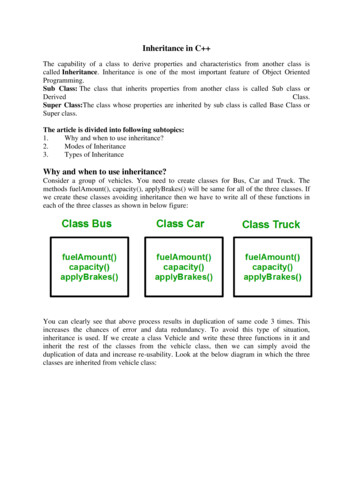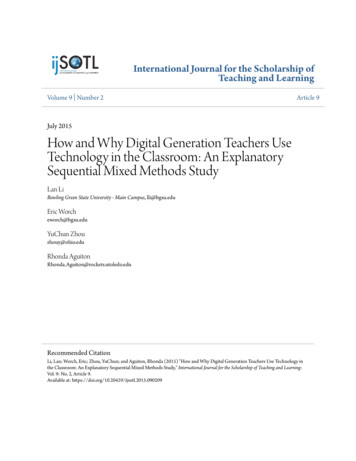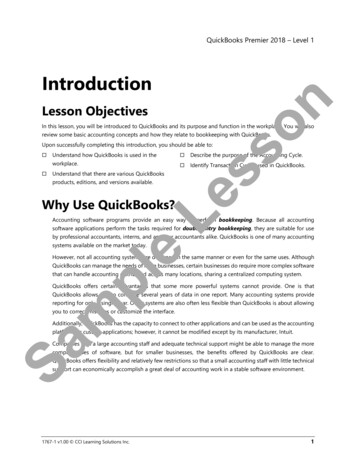
Transcription
Inheritance in C The capability of a class to derive properties and characteristics from another class iscalled Inheritance. Inheritance is one of the most important feature of Object OrientedProgramming.Sub Class: The class that inherits properties from another class is called Sub class orDerivedClass.Super Class:The class whose properties are inherited by sub class is called Base Class orSuper class.The article is divided into following subtopics:1.Why and when to use inheritance?2.Modes of Inheritance3.Types of InheritanceWhy and when to use inheritance?Consider a group of vehicles. You need to create classes for Bus, Car and Truck. Themethods fuelAmount(), capacity(), applyBrakes() will be same for all of the three classes. Ifwe create these classes avoiding inheritance then we have to write all of these functions ineach of the three classes as shown in below figure:You can clearly see that above process results in duplication of same code 3 times. Thisincreases the chances of error and data redundancy. To avoid this type of situation,inheritance is used. If we create a class Vehicle and write these three functions in it andinherit the rest of the classes from the vehicle class, then we can simply avoid theduplication of data and increase re-usability. Look at the below diagram in which the threeclasses are inherited from vehicle class:
Using inheritance, we have to write the functions only one time instead of three times as wehave inherited rest of the three classes from base class(Vehicle).Implementing inheritance in C : For creating a sub-class which is inherited from ass subclass name : access mode base class name{//body of subclass};Here, subclass name is the name of the sub class, access mode is the mode in which youwant to inherit this sub class for example: public, private etc. and base class name is thename of the base class from which you want to inherit the sub class.Note: A derived class doesn’t inherit access to private data members. However, it doesinherit a full parent object, which contains any private members which that class declares.// C program to demonstrate implementation// of Inheritance#include bits/stdc .h using namespace std;//Base classclass Parent{public:int id p;};// Sub class inheriting from Base Class(Parent)class Child : public Parent{public:int id c;
};//main functionint main(){Child obj1;// An object of class child has all data members// and member functions of class parentobj1.id c 7;obj1.id p 91;cout "Child id is " obj1.id c endl;cout "Parent id is " obj1.id p endl;return 0;}Output:Child id is 7Parent id is 91In the above program the ‘Child’ class is publicly inherited from the ‘Parent’ class so thepublic data members of the class ‘Parent’ will also be inherited by the class ‘Child’.Modes of Inheritance1.Public mode: If we derive a sub class from a public base class. Then the publicmember of the base class will become public in the derived class and protected members ofthe base class will become protected in derived class.2.Protected mode: If we derive a sub class from a Protected base class. Then bothpublic member and protected members of the base class will become protected in derivedclass.3.Private mode: If we derive a sub class from a Private base class. Then both publicmember and protected members of the base class will become Private in derived class.Note : The private members in the base class cannot be directly accessed in the derivedclass, while protected members can be directly accessed. For example, Classes B, C and Dall contain the variables x, y and z in below example. It is just question of access.// C Implementation to show that a derived class// doesn’t inherit access to private data members.// However, it does inherit a full parent objectclass A{public:int x;protected:int y;private:int z;};
class B : public A{// x is public// y is protected// z is not accessible from B};class C : protected A{// x is protected// y is protected// z is not accessible from C};class D : private A // 'private' is default for classes{// x is private// y is private// z is not accessible from D};The below table summarizes the above three modes and shows the access specifier of themembers of base class in the sub class when derived in public, protected and private modes:Types of Inheritance in C 1.Single Inheritance: In single inheritance, a class is allowed to inherit from only nly.
Syntax:class subclass name : access mode base class{//body of subclass};// C program to explain// Single inheritance#include iostream using namespace std;// base classclass Vehicle {public:Vehicle(){cout "This is a Vehicle" endl;}};// sub class derived from two base classesclass Car: public Vehicle{};// main functionint main(){// creating object of sub class will// invoke the constructor of base classesCar obj;return 0;}Output:This is a vehicle2.Multiple Inheritance: Multiple Inheritance is a feature of C where a class caninherit from more than one classes. i.e one sub class is inherited from more than one baseclass
Syntax:class subclass name : access mode base class1, access mode base class2, .{//body of subclass};Here, the number of base classes will be separated by a comma (‘, ‘) and access mode forevery base class must be specified.// C program to explain// multiple inheritance#include iostream using namespace std;// first base classclass Vehicle {public:Vehicle(){cout "This is a Vehicle" endl;}};// second base classclass FourWheeler {public:FourWheeler(){cout "This is a 4 wheeler Vehicle" endl;}};// sub class derived from two base classesclass Car: public Vehicle, public FourWheeler {};// main functionint main(){// creating object of sub class will// invoke the constructor of base classesCar obj;return 0;}
Output:This is a VehicleThis is a 4 wheeler Vehicle3.Multilevel Inheritance: In this type of inheritance, a derived class is created fromanother derived class.// C program to implement// Multilevel Inheritance#include iostream using namespace std;// base classclass Vehicle{public:Vehicle(){cout "This is a Vehicle" endl;}};class fourWheeler: public Vehicle{ public:fourWheeler(){cout "Objects with 4 wheels are vehicles" endl;}};// sub class derived from two base classesclass Car: public fourWheeler{public:car(){cout "Car has 4 Wheels" endl;}
};// main functionint main(){//creating object of sub class will//invoke the constructor of base classesCar obj;return 0;}output:This is a VehicleObjects with 4 wheels are vehiclesCar has 4 Wheels4.Hierarchical Inheritance: In this type of inheritance, more than one sub class isinherited from a single base class. i.e. more than one derived class is created from a singlebase class.// C program to implement// Hierarchical Inheritance#include iostream using namespace std;// base classclass Vehicle{public:Vehicle(){cout "This is a Vehicle" endl;}};// first sub class
class Car: public Vehicle{};// second sub classclass Bus: public Vehicle{};// main functionint main(){// creating object of sub class will// invoke the constructor of base classCar obj1;Bus obj2;return 0;}Output:This is a VehicleThis is a Vehicle5.Hybrid (Virtual) Inheritance: Hybrid Inheritance is implemented by combiningmore than one type of inheritance. For example: Combining Hierarchical inheritance andMultiple Inheritance.Below image shows the combination of hierarchical and multiple inheritance:// C program for Hybrid Inheritance#include iostream using namespace std;// base classclass Vehicle{
public:Vehicle(){cout "This is a Vehicle" endl;}};//base classclass Fare{public:Fare(){cout "Fare of Vehicle\n";}};// first sub classclass Car: public Vehicle{};// second sub classclass Bus: public Vehicle, public Fare{};// main functionint main(){// creating object of sub class will// invoke the constructor of base classBus obj2;return 0;}Output:This is a VehicleFare of VehicleA special case of hybrid inheritance : Multipath inheritance:A derived class with two base classes and these two base classes have one common baseclass is called multipath inheritance. An ambiguity can arrise in this type of inheritance.
Consider the following program:// C program demonstrating ambiguity in Multipath Inheritance#include iostream.h #include conio.h class ClassA{public:int a;};class ClassB : public ClassA{public:int b;};class ClassC : public ClassA{public:int c;};class ClassD : public ClassB, public ClassC{public:int d;};void main(){ClassD obj;//obj.a 10;//obj.a 100;//Statement 1, Error//Statement 2, Error
obj.ClassB::a 10;obj.ClassC::a 100;//Statement 3//Statement 4obj.b 20;obj.c 30;obj.d 40;cout "\n A from ClassB : " obj.ClassB::a;cout "\n A from ClassC : " obj.ClassC::a;cout "\n B : " obj.b;cout "\n C : " obj.c;cout "\n D : " obj.d;}Output:A from ClassB : 10A from ClassC : 100B : 20C : 30D : 40In the above example, both ClassB & ClassC inherit ClassA, they both have single copy ofClassA. However ClassD inherit both ClassB & ClassC, therefore ClassD have two copiesof ClassA, one from ClassB and another from ClassC.If we need to access the data member a of ClassA through the object of ClassD, we mustspecify the path from which a will be accessed, whether it is from ClassB or ClassC, bco’zcompiler can’t differentiate between two copies of ClassA in ClassD.There are 2 ways to avoid this ambiguity:1.Use scope resolution operator2.Use virtual base classAvoiding ambiguity using scope resolution operator:Using scope resolution operator we can manually specify the path from which data membera will be accessed, as shown in statement 3 and 4, in the above example.filter noneeditplay arrowbrightness 4obj.ClassB::a 10;//Statement 3obj.ClassC::a 100;//Statement 4Note : Still, there are two copies of ClassA in ClassD.
Avoiding ambiguity using virtual base class:include iostream.h #include conio.h class ClassA{public:int a;};class ClassB : virtual public ClassA{public:int b;};class ClassC : virtual public ClassA{public:int c;};class ClassD : public ClassB, public ClassC{public:int d;};void main(){ClassD obj;obj.a 10;obj.a 100;//Statement 3//Statement 4obj.b 20;obj.c 30;obj.d 40;cout "\n A : " obj.a;cout "\n B : " obj.b;cout "\n C : " obj.c;cout "\n D : " obj.d;}Output:A : 100B : 20C : 30D : 40
According to the above example, ClassD has only one copy of ClassA, therefore, statement4 will overwrite the value of a, given at statement 3.Virtual base class in C Virtual base classes are used in virtual inheritance in a way of preventing multiple“instances” of a given class appearing in an inheritance hierarchy when using multipleinheritances.Need for Virtual Base Classes:Consider the situation where we have one class A .This class is A is inherited by two otherclasses B and C. Both these class are inherited into another in a new class D as shown infigure below.As we can see from the figure that data members/function of class A are inherited twice toclass D. One through class B and second through class C. When any data / function memberof class A is accessed by an object of class D, ambiguity arises as to which data/function
member would be called? One inherited through B or the other inherited through C. Thisconfuses compiler and it displays error.Example: To show the need of Virtual Base Class in C #include iostream using namespace std;class A {public:void show(){cout "Hello form A \n";}};class B : public A {};class C : public A {};class D : public B, public C {};int main(){D object;object.show();}Compile Errors:prog.cpp: In function 'int main()':prog.cpp:29:9: error: request for member 'show' is ambiguousobject.show(); prog.cpp:8:8: note: candidates are: void A::show()void show() prog.cpp:8:8: note:void A::show()How to resolve this issue?To resolve this ambiguity when class A is inherited in both class B and class C, it isdeclared as virtual base class by placing a keyword virtual as :Syntax for Virtual Base Classes:Syntax 1:class B : virtual public A
{};Syntax 2:class C : public virtual A{};Note: virtual can be written before or after the public. Now only one copy of data/functionmember will be copied to class C and class B and class A becomes the virtual base class.Virtual base classes offer a way to save space and avoid ambiguities in class hierarchies thatuse multiple inheritances. When a base class is specified as a virtual base, it can act as anindirect base more than once without duplication of its data members. A single copy of itsdata members is shared by all the base classes that use virtual base.Example 1#include iostream using namespace std;class A {public:int a;A() // constructor{a 10;}};class B : public virtual A {};class C : public virtual A {};class D : public B, public C {};int main(){D object; // object creation of class dcout "a " object.a endl;return 0;}Output:a 10Explanation :The class A has just one data member a which is public. This class isvirtually inherited in class B and class C. Now class B and class C becomes virtual baseclass and no duplication of data member a is done.Example 2:#include iostream using namespace std;
class A {public:void show(){cout "Hello from A \n";}};class B : public virtual A {};class C : public virtual A {};class D : public B, public C {};int main(){D object;object.show();}Output:Hello from A
Hybrid (Virtual) Inheritance: Hybrid Inheritance is implemented by combining more than one type of inheritance. For example: Combining Hierarchical inheritance and Multiple Inheritance. Below image shows the combination of hierarchical and multiple inheritance: // C program for Hybrid Inheritanc











